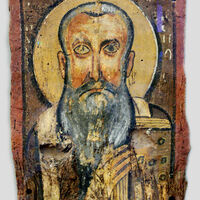Apa Abraham
Type:
Panel paintings,
Icons
Date:
ca. 600
Location or Findspot (Modern-Day Country):
Egypt
Medium:
Encaustic painting,
Wood
Dimensions:
36.5 × 26.5 × 3.2 cm
Description:
Apa (Father) Abraham (ca. 554–ca. 624) was a monk at the remote monastery of Apa Phoibammon, in Upper Egypt. (Apa is the Coptic word for Father.) The patriarch of Alexandria ordered him to relocate the monastery, so Abraham founded a new one with the same name on the upper terrace of the abandoned funerary Temple of Hatshepsut, the female pharaoh (d. 1458 BCE). Abraham ruled there as abbot while also serving as the bishop of Hermonthis. Papyri written in Coptic preserve his correspondence, and a will in Greek gives information about the monastery and details provisions for Abraham's burial and commemorative services. The monastery seems to have been abandoned in the eighth century.
An encaustic painting of Apa Abraham survives, as well as silver altar furnishings, some of them inscribed "Abraham" in Greek. The idealized portrait, inscribed "Apa Abraham the bishop," depicts a mature, bearded man holding a Gospel book. He wears a white, scarflike omophorion that signals his episcopal status. The bust-length image resembles an early Christian icon, and the bishop has a halo even though he was not officially a saint. His community may have hoped he would become one, and he was probably considered an effective intercessor between the monks and the heavenly court. Four holes suggest that the wooden panel was hung on a wall for supplication or veneration.
An encaustic painting of Apa Abraham survives, as well as silver altar furnishings, some of them inscribed "Abraham" in Greek. The idealized portrait, inscribed "Apa Abraham the bishop," depicts a mature, bearded man holding a Gospel book. He wears a white, scarflike omophorion that signals his episcopal status. The bust-length image resembles an early Christian icon, and the bishop has a halo even though he was not officially a saint. His community may have hoped he would become one, and he was probably considered an effective intercessor between the monks and the heavenly court. Four holes suggest that the wooden panel was hung on a wall for supplication or veneration.
Relevant Textbook Chapter(s):
3
Repository and Online Resources:
• Skulpturensammlung und Museum für Byzantinische Kunst | Museum für Byzantinische Kunst
• Hear a lecture about Coptic icons by icon painter Eleanor Rophael, given at the Library of Congress in 2017.
Image Credits:
Wikimedia Commons; Museum für Byzantinische Kunst, Berlin



